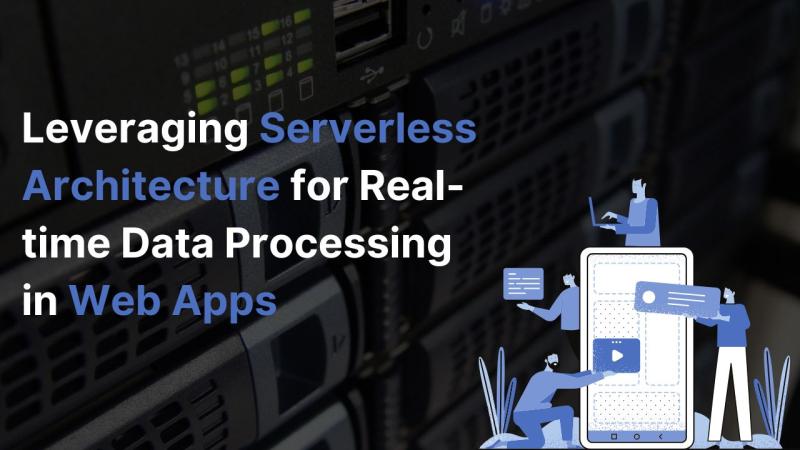Leveraging Serverless Architecture for Real-time Data Processing in Web Apps

In today's fast-paced digital landscape, real-time data processing has become critical for delivering enhanced user experiences in web applications. From live financial data streaming to real-time notifications on social platforms, the demand for immediate data updates has grown exponentially. Traditionally, such capabilities required substantial server resources and intricate architectures. However, with the advent of serverless architecture, web app developers can now process real-time data more efficiently without the overhead of managing dedicated servers.
Serverless architecture offers scalability, reduced operational costs, and improved application time-to-market. By leveraging cloud providers' serverless platforms, web and mobile app development companies can shift their focus from managing infrastructure to developing core functionalities that drive business value. This article explores how serverless architecture can be leveraged for real-time data processing in web apps, addressing its advantages and potential challenges.Understanding Serverless Architecture
Serverless architecture refers to a cloud-computing execution model where cloud providers manage the infrastructure and automatically allocate resources as needed. Developers only write the business logic in functions, and the platform handles the rest, including scaling, load balancing, and maintaining the servers.
Popular platforms like AWS Lambda, Azure Functions, and Google Cloud Functions have revolutionized how web apps are built and scaled. By utilizing these platforms, web app developers no longer need to worry about server provisioning, configuration, or maintenance. Instead, they can focus on creating and deploying code that directly interacts with user data.
For real-time data processing, serverless platforms can automatically trigger functions based on events such as HTTP requests, database changes, or file uploads. This event-driven nature makes serverless ideal for handling high-throughput, low-latency tasks like real-time data processing, where responsiveness and scalability are critical.
Real-Time Data Processing: Challenges and Solutions
Real-time data processing requires the ability to ingest, analyze, and output data with minimal latency. In traditional architectures, this was achieved using dedicated servers or clusters of servers designed for high availability and low-latency processing. However, these setups often involved significant infrastructure costs and operational complexities as traffic and data volumes scaled.
Serverless architectures address these challenges in the following ways:
- Event-Driven Execution: Functions in serverless architectures can be triggered by specific events, making them ideal for real-time data workflows. For example, a function could be triggered when a new message is added to a message queue, instantly processing the data without delay.
- Auto-Scaling: One of the most significant advantages of serverless is its ability to scale automatically. The cloud provider dynamically provisions the necessary resources to handle the traffic as data loads increase. This is particularly useful for web apps experiencing fluctuating data volumes, such as social media platforms, during peak times.
- Cost Efficiency: Traditional real-time processing systems require always-on servers, leading to high costs even during periods of low traffic. With serverless, you only pay for the computing resources when your function runs. This "pay-as-you-go" model makes real-time data processing much more cost-effective for many web app development companies.
Use Cases for Serverless in Real-Time Processing
Several industries and applications can benefit from using serverless architecture for real-time data processing:
- Financial Services: Real-time transaction processing and fraud detection require immediate responses to data changes. By leveraging serverless functions, financial apps can process data streams in real-time, allowing faster detection of anomalies or fraudulent activities.
- IoT and Edge Computing: IoT devices generate vast amounts of data that must be processed in real time for insights and actions. Serverless architectures are ideal for handling the influx of data from IoT sensors, analyzing it as it streams in, and responding to events in near real time.
- Media and Entertainment: Streaming services and gaming platforms rely on real-time processing for features such as live video encoding or multiplayer synchronization. Serverless enables these platforms to process and distribute content efficiently as user engagement spikes.
- Chat and Collaboration Tools: Web apps like messaging platforms and collaboration tools require real-time updates to maintain a seamless user experience. Serverless architecture allows these apps to handle thousands of simultaneous connections and process data instantly, ensuring smooth communication between users.
Limitations and Considerations
While serverless architectures provide numerous advantages for real-time data processing, there are also limitations to consider:
- Cold Starts: One of the primary concerns with serverless functions is the cold start issue. When a function is invoked for the first time after a period of inactivity, there may be a delay (known as a cold start) as the server allocates resources and initializes the function. This delay can affect performance in real-time processing scenarios, although many cloud providers are working to minimize cold start times.
- Execution Time Limits: Serverless platforms often impose execution time limits on functions. For example, AWS Lambda has a maximum execution time of 15 minutes. While this is sufficient for most real-time tasks, longer processes may require breaking down workflows into smaller, modular functions or integrating serverless with traditional server-based services.
- Vendor Lock-In: Relying on a specific cloud provider for serverless architecture can lead to vendor lock-in, limiting the flexibility to switch platforms in the future. To mitigate this risk, web app developers should evaluate the long-term implications and explore multi-cloud or hybrid solutions.
Conclusion
Serverless architecture has transformed how modern web applications handle real-time data processing, providing scalability, cost efficiency, and reduced operational complexity. By leveraging serverless platforms, a web app development company can focus on building innovative features rather than managing infrastructure. While there are challenges, such as cold starts and execution limits, the benefits of serverless for real-time data processing far outweigh the drawbacks for most use cases.
For web app development, serverless offers an attractive solution to manage real-time data processing effectively. This allows applications to deliver faster, more responsive user experiences. As the technology matures, it's expected that serverless will continue to play a vital role in shaping the future of web application architecture.
Comments